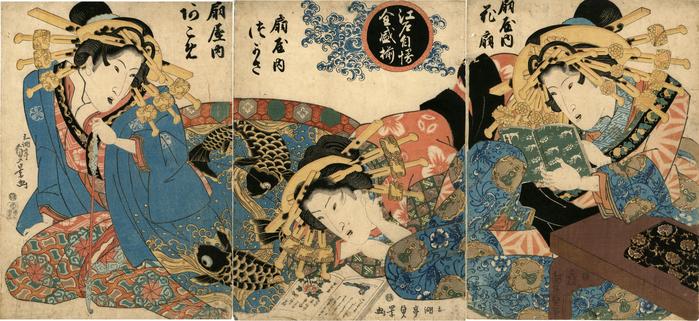Utagawa Sadakage (歌川貞景) (artist )
The Pride of Edo Seen in a Collection of Courtesans (江戸自慢全盛揃) - Hanaōgi (花扇) on the right, Tsukasa (つかさ) in the center, Akome (あこめ) on the left - all of the Ōgi house (扇屋内)
ca 1830
12.25 in x 14.25 in (Overall dimensions) Japanese woodblock print
Signed: Gokotei Sadakage ga
五湖亭貞景画
Publisher: Tsuruya Kiemon (Marks 553 - seal 22-066)
Censor's seal: kiwame
Museum für angewandte Kunst, Vienna - left panel
Museum für angewandte Kunst, Vienna - center panel
Museum für angewandte Kunst, Vienna - right panel
Museum of Fine Arts, Boston - center panel
Lyon Collection - another example of this triptych
British Museum - Tsukasa of Ōgiya by Eisui, ca. 1797
Museum of Fine Arts, Boston - Tsukasa of the Higashi-Ōgiya in Osaka, by Chōki in the 1790s
Museum of Fine Arts, Boston - Tsukasa of Ōgiya by Eisen from the early 1820 - either the same courtesan or her predecessor
Museum of Fine Arts, Boston - Tsukasa of Ōgiya by Shikimaro from 1813
Victoria and Albert Museum - the center panel only
Victoria and Albert Museum - the left-hand panel
Victoria and Albert Museum - the right-hand panel only This remarkable and powerful design is considered to be one of Sadakage's masterpieces. Although the figures are monumental, Sadakage has managed to create on elegant and delightful image with them. The triptych is as rare as it is beautiful.
The kanzashi hair pins worn by Tsukasa in the center panel at first glance might appear to be only abstract designs, but in an enlarged view one can see that they are bats either flying among clouds or above roiling waters. Part of her clothing shows a design of crossed scrolls which are often seen as a propitious symbol, a symbol which was also adopted as a crest for the Nakamura clan of actors.
Hanaogi, on the right, is wearing outer kanzashi made up of alternating fan and eboshi designs. Her six inner hair pins are decorated with flowers. The kanzoshi of Akome on the left display gourds hanging among their vines.
****
The courtesan in the center panel, leaning on her elbows to read a book, is Tsukasa of the Ōgiya. Many artists portrayed famous courtesans who were given the honor of using this name. Considering the time frame, they could not all have been of the same woman. A courtesan, even a high-ranking one, would be at the peak of her beauty and skill level for only a few years at most. There for a Tsukasa portrayed by Eisui or Choki in the last few years of the 18th century would not be the same Tsukasa being portrayed here approximately 30 years later. Therefore, a particularly beautiful and sought after woman at the Ōgiya might be honored by being given the same name as a predecessor who was known for her great elegance and style.
****
All three of the women have blackened their teeth, a practice of ohaguro, a fashion statement of their day. The one on the left has also used sasabeni (笹紅), a lip gloss that was terrible expensive. When painted on in layers it started out red, but turned to an iridescent green after several applications.
beautiful woman picture (bijin-ga - 美人画) (genre)
Tsuruya Kiemon (鶴屋喜右衛門) (publisher)
